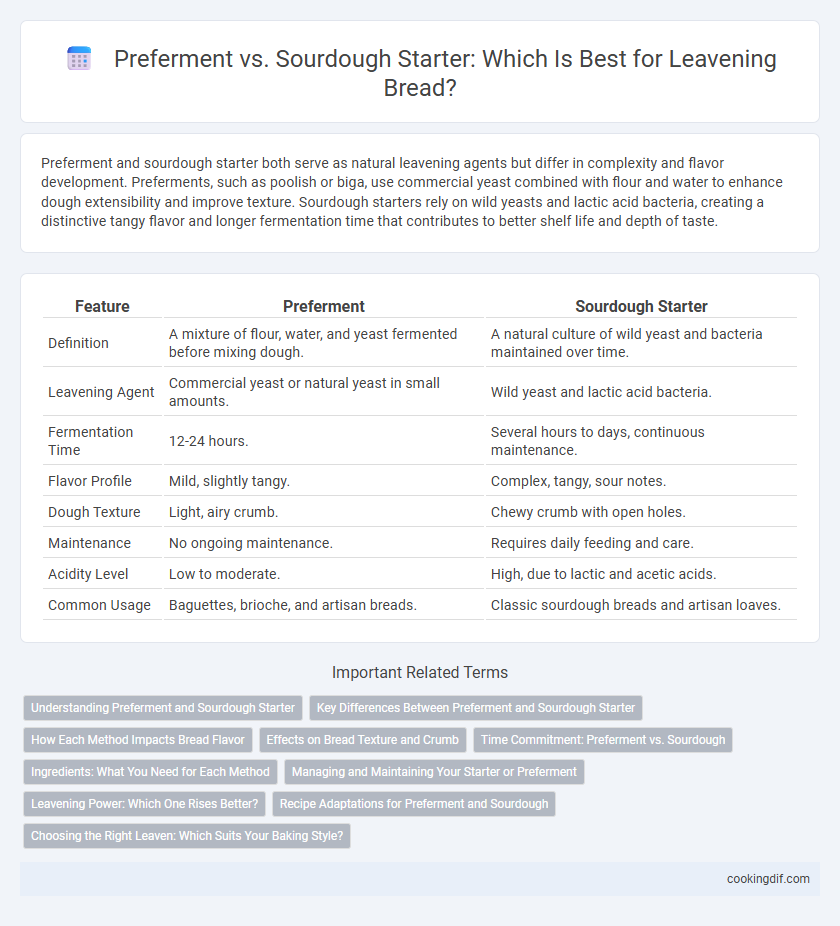Preferment and sourdough starter both serve as natural leavening agents but differ in complexity and flavor development. Preferments, such as poolish or biga, use commercial yeast combined with flour and water to enhance dough extensibility and improve texture. Sourdough starters rely on wild yeasts and lactic acid bacteria, creating a distinctive tangy flavor and longer fermentation time that contributes to better shelf life and depth of taste.
Table of Comparison
| Feature | Preferment | Sourdough Starter |
|---|---|---|
| Definition | A mixture of flour, water, and yeast fermented before mixing dough. | A natural culture of wild yeast and bacteria maintained over time. |
| Leavening Agent | Commercial yeast or natural yeast in small amounts. | Wild yeast and lactic acid bacteria. |
| Fermentation Time | 12-24 hours. | Several hours to days, continuous maintenance. |
| Flavor Profile | Mild, slightly tangy. | Complex, tangy, sour notes. |
| Dough Texture | Light, airy crumb. | Chewy crumb with open holes. |
| Maintenance | No ongoing maintenance. | Requires daily feeding and care. |
| Acidity Level | Low to moderate. | High, due to lactic and acetic acids. |
| Common Usage | Baguettes, brioche, and artisan breads. | Classic sourdough breads and artisan loaves. |
Understanding Preferment and Sourdough Starter
Preferment is a mixture of flour, water, and a small amount of commercial yeast fermented before the final dough, enhancing flavor and texture while providing consistent leavening. Sourdough starter relies on naturally occurring wild yeast and lactic acid bacteria cultivated over time, contributing complex tangy flavors and improved digestibility. Understanding the biochemical activity in preferments versus sourdough starters helps bakers control fermentation speed, acidity, and bread crumb structure effectively.
Key Differences Between Preferment and Sourdough Starter
Preferment is a mix of flour, water, and a small amount of commercial yeast allowed to ferment before incorporating into the dough, producing a consistent rise and mild flavor. Sourdough starter consists of wild yeast and lactic acid bacteria cultivated over time, imparting unique tangy flavors and longer fermentation periods. Key differences include microbial composition, fermentation duration, flavor complexity, and dependency on commercial yeast versus natural wild yeast.
How Each Method Impacts Bread Flavor
Preferment methods, such as poolish or biga, contribute to a mild, slightly tangy flavor with enhanced depth and subtle sweetness due to extended fermentation times. Sourdough starters impart a distinctly complex, tangy, and robust flavor profile, driven by wild yeast and lactic acid bacteria fermentation that develops organic acids and aromatic compounds. The choice between preferment and sourdough starter profoundly influences the bread's aroma, crust texture, and overall taste complexity.
Effects on Bread Texture and Crumb
Preferment improves bread texture by enhancing gluten development, resulting in a more open, airy crumb with a slightly chewy bite. Sourdough starter emphasizes natural fermentation, producing a denser crumb with complex flavor and increased moisture retention. Both leavening methods influence crumb structure, but preferment often yields a lighter texture while sourdough creates a robust, tangy crumb.
Time Commitment: Preferment vs. Sourdough
Preferment requires a shorter fermentation period of approximately 12 to 16 hours, making it ideal for bakers needing faster leavening while still enhancing flavor and texture. Sourdough starter demands a longer time investment, often 24 to 48 hours or more, due to its natural wild yeast cultivation and slower fermentation process. Time efficiency benefits preferment, whereas sourdough starter offers more depth of flavor with extended preparation.
Ingredients: What You Need for Each Method
Preferment requires a combination of flour, water, and a small amount of yeast, allowing fermentation to develop flavor and texture over several hours. Sourdough starter relies on wild yeast and lactic acid bacteria naturally present in flour and the environment, consisting of flour and water maintained through regular feedings. Both methods use similar base ingredients but differ in microbial cultures and fermentation time, impacting the dough's rise and crumb structure.
Managing and Maintaining Your Starter or Preferment
Managing a sourdough starter requires regular feedings with flour and water to maintain its microbial balance and leavening power, while preferments like poolish or biga need shorter fermentation times and precise temperature control to develop flavor and structure. Maintaining optimal hydration, temperature, and feeding schedule ensures active yeast and bacterial growth in sourdough starters, whereas preferments rely on immediate use after achieving peak fermentation. Proper storage, such as refrigeration for sourdough starters and room temperature for preferments, influences their metabolic activity and ultimately the bread's rise and crumb texture.
Leavening Power: Which One Rises Better?
Preferment, such as poolish or biga, offers controlled fermentation with a moderate rise due to commercial yeast's predictable leavening power, producing a light and airy crumb. Sourdough starter relies on wild yeast and lactic acid bacteria, resulting in slower fermentation but stronger flavor complexity and natural leavening strength, which can create a denser, more textured rise. The optimal rising power depends on desired bread characteristics, with preferment excelling in volume and sourdough providing robust, tangy flavor with moderate lift.
Recipe Adaptations for Preferment and Sourdough
Recipe adaptations for preferment leavening often involve adjusting fermentation time and hydration levels to maximize flavor development and dough strength, typically requiring longer bulk fermentation and higher water content. Sourdough starter adaptations focus on maintaining starter vitality through regular feedings and balancing acidity, influencing dough elasticity and crumb texture. Both methods benefit from precise temperature control and hydration adjustments to optimize yeast and bacterial activity for consistent leavening results.
Choosing the Right Leaven: Which Suits Your Baking Style?
Choosing the right leaven is essential for bread baking, with preferments like poolish, biga, or sponge offering predictable fermentation and milder flavors suited for structured crumb and quicker preparation. Sourdough starters, composed of wild yeast and lactobacilli, develop complex, tangy flavors and require longer fermentation times, ideal for bakers valuing artisanal character and natural leavening. Assessing your baking timeline, desired taste profile, and fermentation control helps determine if preferment or sourdough starter aligns with your bread-making style.
Preferment vs sourdough starter for leavening Infographic

 cookingdif.com
cookingdif.com